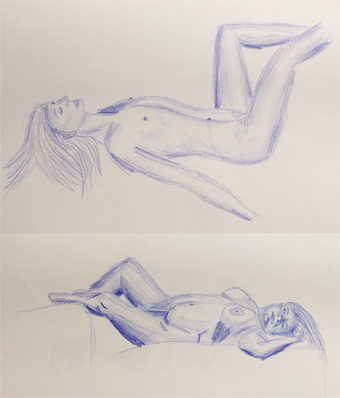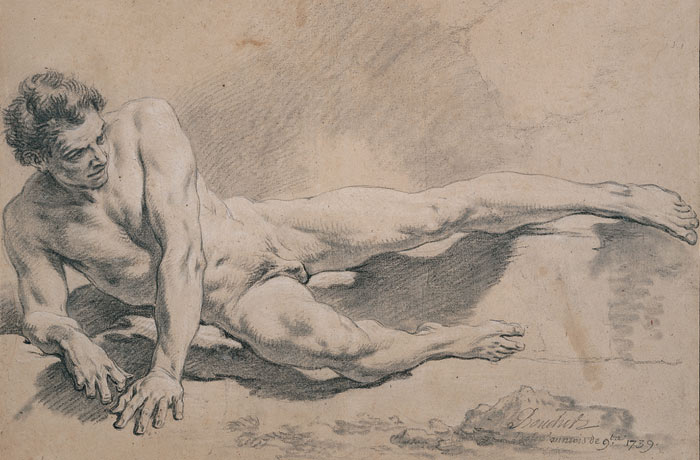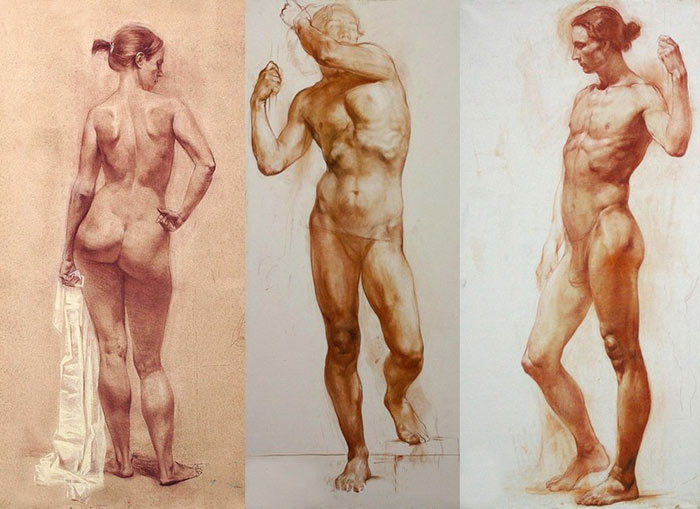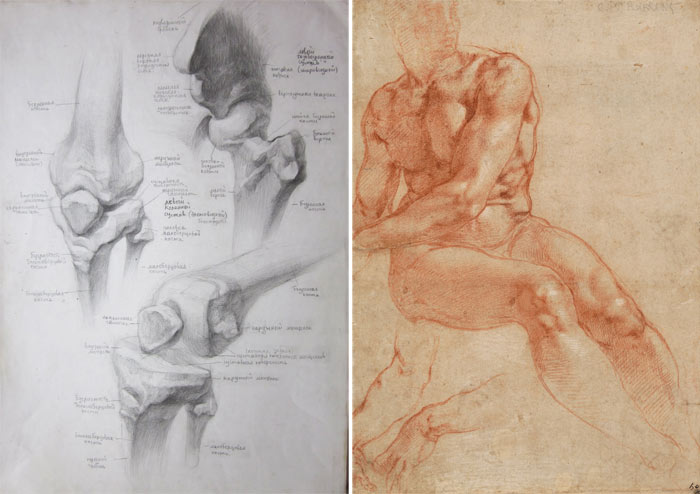Drawings for critique from Jeff, Drawing Academy student
 I continue to attend figure drawing sessions from time to time.
I continue to attend figure drawing sessions from time to time.
Recently, I did these two drawings in blue Prismacolor Premier colored pencil.
Each drawing was based on a single 20-minute pose.
I tried to improve the models’ faces based on your video lessons on how to draw a mouth, nose, ears, etc.
However, I still find it difficult, especially when I only have 20 minutes to complete the whole drawing.
I am interested in any feedback you have for me.
Thank you,
Jeff
Hi Jeff,
Many thanks for your life drawings.
It is great that you draw from life. This is the right way to improve your figurative drawing skills.
Your drawings are fine for fast sketches – but of course, there are certain things you can consider to push your skills farther.
1. I would suggest using graphite pencil for learning. Colored pencils are good for creative artworks, yet drawing mistakes are more difficult to spot.
2. Reclining poses are more difficult than standing ones. So you did a good job, taking this point into account.

3. 20 minutes or less per pose is not enough time for a beginner.
Here’s how life drawing should be approached: first, you need to study long poses (1…2+ hours) of standing models. The purpose is to put in practice the knowledge of human body proportions and anatomy, which of course you have to learn before attempting life drawing.
When you are comfortable with drawing long poses and applying proportions with ease, then you will be able to work on improving speed and virtuosity.

There is a notion that life drawing should start with short 1…5 minute poses to warm up and polish drawing skills. That might be so for a professional figurative artist who already spent hundreds of hours drawing from life and has the necessary knowledge and experience. For a beginner, this would be waste of time. If you don’t know how to draw a figure, then doing it fast under time pressure won’t help.
I understand that you have no choice of pose timing; therefore do not try to finish the whole figure and attempt to render tonal values. There are much more important things – like drawing correct proportions and using constructive drawing principles. Rendering tonal values in this case is like painting walls of a house that hasn’t been built yet.
4. There is a step-by-step sequence of how to draw a model from life. You can learn this sequence in the Anatomy Master Class video lessons.
5. Above all, learn a human anatomy for artists.
An artist has no chances of producing correct realistic artworks when drawing human figures from life, memory or imagination without the necessary knowledge of anatomy. Just take my word for it. You can spend hundreds of hours practicing life drawing and end up making a collection of artworks full of mistakes. Many mistakes you won’t even understand – you’d just get a feeling that something is not right in your sketches.
6. In life drawing, it is more critical than in any other genre to draw what you know, not what you see. For example, if you don’t know the construction of a knee and how it changes when a leg is bent, there is no chance you would depict it realistically by simply copying what you observe on a model. That’s because you wouldn’t understand and therefore see what makes the knee’s shape.

7. Draw “thoughtfully” instead of copying model’s shapes and outlines.
This means you need to run a constant conversation in your head asking and solving an endless line of questions, such as: “where is the center of the body; how many times this model’s head fits into the total height; is pelvis wider than a ribcage; is the distance from the chin to the pit of the neck equal to the width of the hand,” and so on. The moment you stop reconciling similar questions, you are not drawing, but copying – which will result in mistakes.
To learn the human anatomy for artists fast, enroll in the Anatomy Master Class »
Best regards,
Vladimir
To learn professional drawing techniques,
Enroll in the Drawing Academy Course
Pay once - Enjoy forever!
Only $297






Good mornig,
I totally agree with you.
Thank you very much.
Best regards,
Santha
Vladimir. This may sound stupid but your critique slips into what I would classify as breath taking. How much information you cram into so brief a remark is somewhat stunning. I have saved nearly all the e-mails I have received as a guest by invitation because they present such crucial information for anyone struggeling to enhance their drawing. These bits of information collectively become art courses in and of themselves.
So many books on art anatomy are nothing more than anatomy books simplified with no information directly related to art. Thank you for those little bits.
Tom